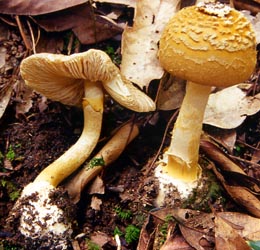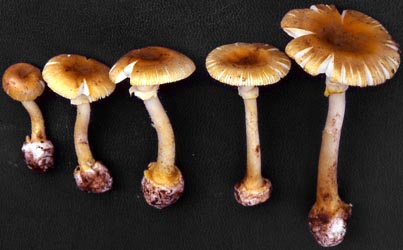|
Amanita
pseudogemmata Hongo
BRIEF DESCRIPTION: The fruiting bodies of A. pseudogemmata are small to medium-sized. The cap is 40-90 mm wide, convex to applanate, yellowish to pale yellow-brown, paler towards the margin; its margin is short-striate; it is covered with brownish grey to olivaceous brown verrucouse to farinose volval remnants. Its trama is white. The gills of this species are free, crowded, cream-colored; and the short gills are truncate, and of diverse lengths. The stem
is 60 - 100 x 5 – 15 mm, subcylindrical to attenuate upwards; its
surface is cream-colored to white, and covered with yellow to brownish
yellow squamules; the stem's basal bulb is 15 - 40 mm wide, limbate to
subtruncate. The annulus is persistent, its upper surface is white and
its lower surface, yellowish. Spores
of A. pseudogemmata measure (6.0-) 7.0-9.5 (-10.5) × (5.5) 6.0-8.5 (-9.5) µm and are
broadly ellipsoid to ellipsoid, and inamyloid. Clamps are not present
at the bases of basidiae. Amanita
pseudogemmata
was originally described from Japan. It occurs in broad-leaved forests
with fagaceous plants. It has been known from China and Japan. Amanita pseudogemmata is characterized by its yellowish to brownish yellow pileus with brownish grey to olivaceous brown verrucouse to farinose volval remnants; limbate to subtruncate basal bulb; inamyloid, broadly ellipsoid to ellipsoid spores; and the absence of clamps. The
reader may wish to make comparison with A.
gemmata
(Fr.) Bertillon in Dechambre and A.
orientigemmata
Zhu L. Yang & Yoshim. Doi.
– Zhu L. Yang Photos: Zhu L. Yang (Yunnan Province, China). Return to Section Amanita page. Last changed 3 October 2005. |

